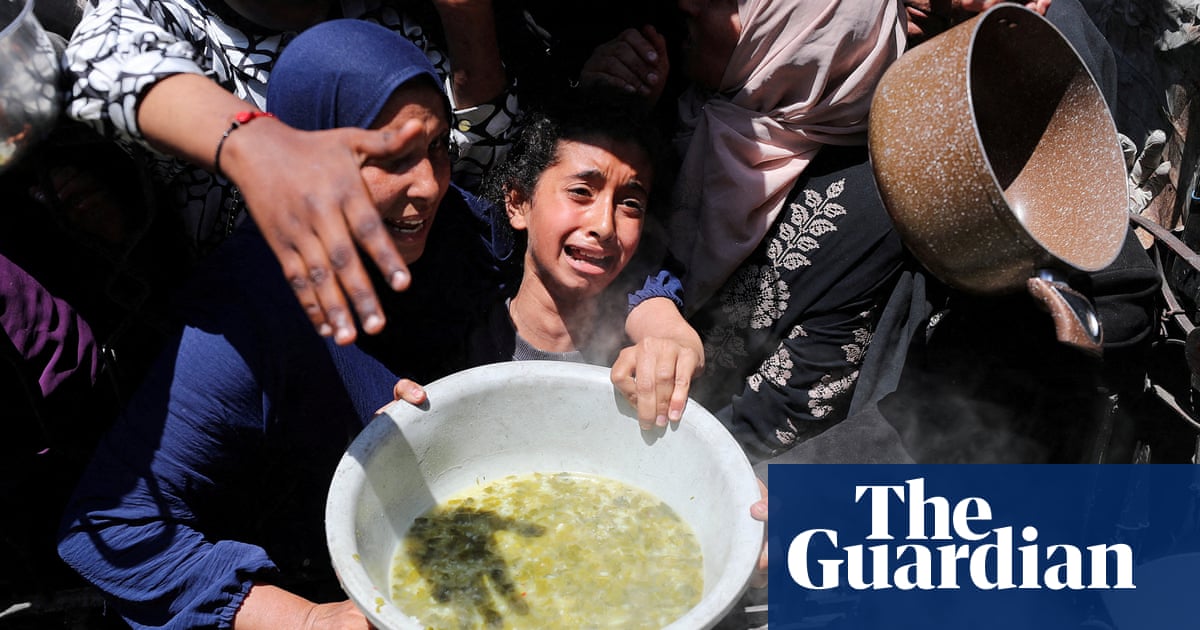Gaza is at “critical risk of famine”, food security experts have warned, 10 weeks afterIsraelimposed a blockade on the devastated Palestinian territory, cutting off all supplies including food, medicine, shelter and fuel.
In its most recent report, the Integrated Food Security Phase Classification (IPC) said on Monday there had been a “major deterioration” in the food security situation inGazasince its last assessment in October 2024 and that Palestinians living there faced “a critical risk of famine”.
“Goods indispensable for people’s survival are either depleted or expected to run out in the coming weeks. The entire population is facing high levels of acute food insecurity, with half a million people – one in five – facing starvation,” said the IPC, a consortium of independent specialists tasked by the UN and international NGOs with assessing the risk of famine in crises worldwide.
Israel imposed its strict blockade in early March, after the end of the first phase of a supposed three-phase ceasefire. Just over two weeks later, a new wave of attacks by the Israeli military definitively ended the truce.
Aid workers in Gaza told the Guardian that prices for essentials had risen further in recent days, warehouses were empty and humanitarian teams treating malnourished children were being forced to divide rations designed for one between two patients to give both a chance of survival.
“The stocks we brought in during the [two-month-long] ceasefire are running very low. We have treated more than 11,000 children since the beginning of the year … In coming weeks, we fear we will see more children dying,” said Jonathan Crickx, a- spokesperson for Unicef speaking from southern Gaza.
The UN’s Food and Agriculture Organization separately warned that Gaza faced “imminent risk of famine”, saying agriculture was “on the brink of total collapse” and called for the “immediate” lifting of the blockade. Law and order has also suffered in recent weeks as desperate Palestinians and organised gangsexploit growing chaos.
Israeli officials say the blockade aims to pressure Hamas to release the 59 hostages it has been holding since October 2023, when it launched a surprise raid into southern Israel. On Monday, the Islamist militant organisation released the last livingUS-Israeli citizen heldin Gaza, a 21-year-old soldier.
More than 1,200 were killed, mostly civilians, and 251 abducted during the Hamas attack in 2023. More than 52,000 Palestinians have been killed in Gaza during the ensuing offensive and swaths of the territory reduced to rubble.
Israel accuses Hamas of systematically diverting aid to finance its military and other operations, and of using civilians as human shields. Hamas denies both charges.
In Gaza, bakeries run by the World Food Programme shut down weeks ago, all out of flour or fuel. Kitchens that handed out nearly 1m meals every day in Gaza have closed or have limited supplies left.The warehouses of the UN are empty, aid officials said. Prices have risen steadily as basic foodstuffs have become scarcer. A kilo of potatoes and tomatoes in some areas costs more than $10 (£7.60).
Dr Ahmed al-Farah, the director of the children’s and maternity building at the Nasser medical complex in the southern Gaza city of Khan Younis,said last weekthat between five and 10 new malnutrition cases were being recorded there each day.
“We’re seeing severe cases.Malnutritionappears in children in a horrifying and extremely visible way,” Farah said. “We have nothing to offer them. They need proteins, but there are none. We try to provide a little milk, perhaps powdered milk, but we can’t offer anything more.”
Israel has proposeda new system of aid distribution in Gazainvolving individual hubs run by private contractors and protected by Israeli troops. The UN has so far refused to participate in the scheme, which humanitarian officials describe as inadequate, impractical and potentially unlawful.
The IPC, which has developed a five-level famine warning system, found that from 1 April to 10 May, 244,000 people in Gaza were in the most critical food security situation – level five, or “catastrophe/famine”.The consortium, set up in 2004, brings together more than a dozen UN agencies, aid groups, governments and other bodies.
It has rarely declared famine: in Somalia in 2011, and South Sudan in 2017 and 2020, and last year in parts of Sudan’s western Darfur region. The technical definition of a famine is demanding, with at least two of three things observed: 20% of households with an extreme lack of food; at least 30% of children six months to five years old suffering from acute malnutrition; and at least two people or four children under five per every 10,000 dying daily due to starvation or the interaction of malnutrition and disease.
The new IPC assessment found that the first threshold was met in Gaza, saying 477,000 people – or 22% of the population – were classified as facing “catastrophic” hunger, the highest level, for the period from 11 May to the end of September. The other thresholds were not met, however.
Humanitarian officials in Gaza say they fear that by the time a famine is officially declared it will be too late and many will already have died.
The IPC also warned of “imminent” famine in northern Gaza in March 2024, but the following month Israel allowed an influx of aid under US pressure after an Israeli strike killed seven aid workers.
